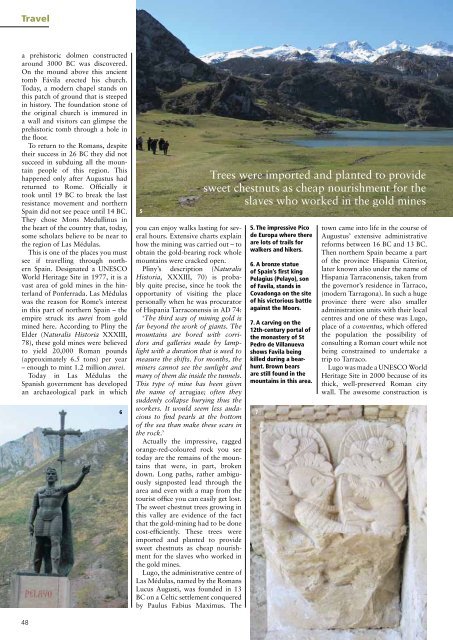Following Odysseus Not the end of the world Amarna city of light ...
Following Odysseus Not the end of the world Amarna city of light ...
Following Odysseus Not the end of the world Amarna city of light ...
- No tags were found...
Create successful ePaper yourself
Turn your PDF publications into a flip-book with our unique Google optimized e-Paper software.
Travela prehistoric dolmen constructedaround 3000 BC was discovered.On <strong>the</strong> mound above this ancienttomb Fávila erected his church.Today, a modern chapel stands onthis patch <strong>of</strong> ground that is steepedin history. The foundation stone <strong>of</strong><strong>the</strong> original church is immured ina wall and visitors can glimpse <strong>the</strong>prehistoric tomb through a hole in<strong>the</strong> floor.To return to <strong>the</strong> Romans, despite<strong>the</strong>ir success in 26 BC <strong>the</strong>y did notsucceed in subduing all <strong>the</strong> mountainpeople <strong>of</strong> this region. Thishappened only after Augustus hadreturned to Rome. Officially ittook until 19 BC to break <strong>the</strong> lastresistance movement and nor<strong>the</strong>rnSpain did not see peace until 14 BC.They chose Mons Medullinus in<strong>the</strong> heart <strong>of</strong> <strong>the</strong> country that, today,some scholars believe to be near to<strong>the</strong> region <strong>of</strong> Las Médulas.This is one <strong>of</strong> <strong>the</strong> places you mustsee if travelling through nor<strong>the</strong>rnSpain. Designated a UNESCOWorld Heritage Site in 1977, it is avast area <strong>of</strong> gold mines in <strong>the</strong> hinterland<strong>of</strong> Ponferrada. Las Médulaswas <strong>the</strong> reason for Rome’s interestin this part <strong>of</strong> nor<strong>the</strong>rn Spain – <strong>the</strong>empire struck its aurei from goldmined here. According to Pliny <strong>the</strong>Elder (Naturalis Historia XXXIII,78), <strong>the</strong>se gold mines were believedto yield 20,000 Roman pounds(approximately 6.5 tons) per year– enough to mint 1.2 million aurei.Today in Las Médulas <strong>the</strong>Spanish government has developedan archaeological park in which65you can enjoy walks lasting for severalhours. Extensive charts explainhow <strong>the</strong> mining was carried out – toobtain <strong>the</strong> gold-bearing rock wholemountains were cracked open.Pliny’s description (NaturalisHistoria, XXXIII, 70) is probablyquite precise, since he took <strong>the</strong>opportunity <strong>of</strong> visiting <strong>the</strong> placepersonally when he was procurator<strong>of</strong> Hispania Tarraconensis in AD 74:‘The third way <strong>of</strong> mining gold isfar beyond <strong>the</strong> work <strong>of</strong> giants. Themountains are bored with corridorsand galleries made by lamp<strong>light</strong>with a duration that is used tomeasure <strong>the</strong> shifts. For months, <strong>the</strong>miners cannot see <strong>the</strong> sun<strong>light</strong> andmany <strong>of</strong> <strong>the</strong>m die inside <strong>the</strong> tunnels.This type <strong>of</strong> mine has been given<strong>the</strong> name <strong>of</strong> arrugiae; <strong>of</strong>ten <strong>the</strong>ysuddenly collapse burying thus <strong>the</strong>workers. It would seem less audaciousto find pearls at <strong>the</strong> bottom<strong>of</strong> <strong>the</strong> sea than make <strong>the</strong>se scars in<strong>the</strong> rock.’Actually <strong>the</strong> impressive, raggedorange-red-coloured rock you seetoday are <strong>the</strong> remains <strong>of</strong> <strong>the</strong> mountainsthat were, in part, brok<strong>end</strong>own. Long paths, ra<strong>the</strong>r ambiguouslysignposted lead through <strong>the</strong>area and even with a map from <strong>the</strong>tourist <strong>of</strong>fice you can easily get lost.The sweet chestnut trees growing inthis valley are evidence <strong>of</strong> <strong>the</strong> factthat <strong>the</strong> gold-mining had to be donecost-efficiently. These trees wereimported and planted to providesweet chestnuts as cheap nourishmentfor <strong>the</strong> slaves who worked in<strong>the</strong> gold mines.Lugo, <strong>the</strong> administrative centre <strong>of</strong>Las Médulas, named by <strong>the</strong> RomansLucus Augusti, was founded in 13BC on a Celtic settlement conqueredby Paulus Fabius Maximus. TheTrees were imported and planted to providesweet chestnuts as cheap nourishment for <strong>the</strong>slaves who worked in <strong>the</strong> gold mines5. The impressive Picode Europa where <strong>the</strong>reare lots <strong>of</strong> trails forwalkers and hikers.6. A bronze statue<strong>of</strong> Spain’s first kingPelagius (Pelayo), son<strong>of</strong> Favila, stands inCovadonga on <strong>the</strong> site<strong>of</strong> his victorious battleagainst <strong>the</strong> Moors.7. A carving on <strong>the</strong>12th-century portal <strong>of</strong><strong>the</strong> monastery <strong>of</strong> StPedro de Villanuevashows Favila beingkilled during a bearhunt.Brown bearsare still found in <strong>the</strong>mountains in this area.7town came into life in <strong>the</strong> course <strong>of</strong>Augustus’ extensive administrativereforms between 16 BC and 13 BC.Then nor<strong>the</strong>rn Spain became a part<strong>of</strong> <strong>the</strong> province Hispania Citerior,later known also under <strong>the</strong> name <strong>of</strong>Hispania Tarraconensis, taken from<strong>the</strong> governor’s residence in Tarraco,(modern Tarragona). In such a hugeprovince <strong>the</strong>re were also smalleradministration units with <strong>the</strong>ir localcentres and one <strong>of</strong> <strong>the</strong>se was Lugo,place <strong>of</strong> a conventus, which <strong>of</strong>fered<strong>the</strong> population <strong>the</strong> possibility <strong>of</strong>consulting a Roman court while notbeing constrained to undertake atrip to Tarraco.Lugo was made a UNESCO WorldHeritage Site in 2000 because <strong>of</strong> itsthick, well-preserved Roman <strong>city</strong>wall. The awesome construction is48
















